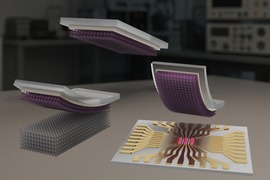A team of MIT engineers has developed a groundbreaking “electronic skin” — a wafer-thin, heat-sensing film that could change how we see in the dark. This innovation promises a new generation of lightweight night vision glasses and has applications across defense, mobility, and environmental sensing.
What Is This Electronic Skin?
The new material is an ultrathin pyroelectric membrane — just 10 nanometers thick — that can detect heat and far-infrared radiation with extreme precision. Unlike traditional infrared sensors, it doesn’t require heavy cooling systems. That’s a game-changer for reducing the bulk and power demands of thermal imaging devices.
How Was It Made?
The MIT team, led by Professor Jeehwan Kim and graduate student Xinyuan Zhang, used a method called remote epitaxy. In this process, a thin layer of graphene is placed between the substrate and the growing film, allowing the final product to be peeled off like a sticker. This not only makes the film reusable but also flexible and scalable.
Why Does This Matter?
Most current night vision technologies rely on cooled infrared sensors, which are bulky and expensive. MIT’s film eliminates the need for cooling, making it possible to build sleek, lightweight night vision glasses — something currently not feasible with existing tech.
This could benefit:
- Soldiers and law enforcement needing mobile, lightweight equipment.
- Outdoor and search-rescue teams operating in challenging environments.
- Everyday consumers as this tech matures and enters the public market.
Beyond Night Vision: Other Uses
The same thermal-sensing capabilities could enable:
- Environmental monitoring — tracking heat patterns in agriculture or ecosystems.
- Health diagnostics — sensing small temperature changes in biological tissues.
- Autonomous vehicles — helping cars detect people, animals, or objects in low visibility conditions.
- Space observation — capturing far-infrared signals from celestial bodies.
What’s Next?
MIT’s team is now working on integrating this “skin” into real-world devices. Their goal? Create working prototypes of night vision glasses and other sensing tools that are faster, cheaper, and better. If successful, this could redefine how machines — and humans — see the world in the dark.
Source: Massachusetts Institute of Technology



 Share your Details for subscribe
Share your Details for subscribe